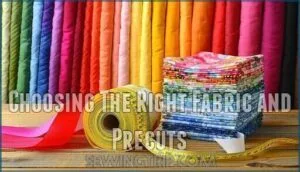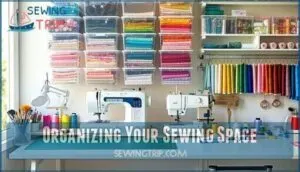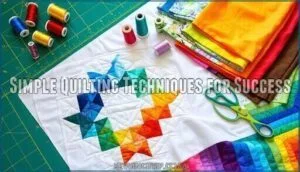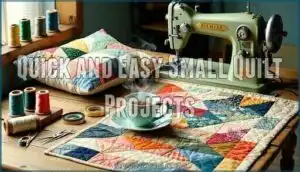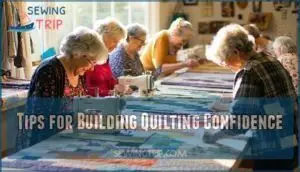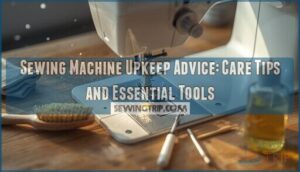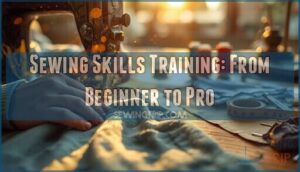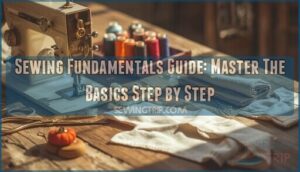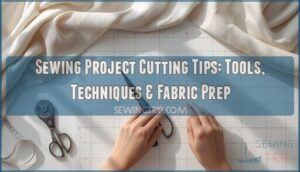This site is supported by our readers. We may earn a commission, at no cost to you, if you purchase through links.
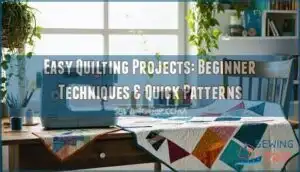 The first quilt you make doesn’t need to be perfect—it just needs to be finished. That shift in mindset transforms quilting from an intimidating craft into something approachable, even for someone who’s never threaded a needle.
The first quilt you make doesn’t need to be perfect—it just needs to be finished. That shift in mindset transforms quilting from an intimidating craft into something approachable, even for someone who’s never threaded a needle.
Most beginners assume they need sophisticated skills or expensive equipment, but easy quilting projects prove otherwise. A simple mug rug or table runner teaches the same fundamental techniques used in complex quilts, minus the overwhelm.
With the right starter supplies and a few basic methods, you can piece together your first project in a weekend. The key isn’t talent or experience; it’s choosing patterns designed for learning, then building confidence one seam at a time.
Table Of Contents
Key Takeaways
- Starting with small projects like mug rugs, coasters, or pillow covers builds fundamental quilting skills without the intimidation of full-sized quilts, with most beginners finishing their first piece in under three hours.
- Precut fabrics (charm squares, jelly rolls, fat quarters) eliminate color-matching guesswork and cutting time, which is why approximately 50% of beginner projects use them to jump straight into piecing.
- Mastering basic techniques—accurate ¼" seam allowances, chain piecing, proper pressing, and foundational blocks like half-square triangles—creates the skill foundation needed for any quilting project, regardless of complexity.
- Free online patterns, video tutorials (used by 65% of beginners), and quilting communities provide accessible learning resources that turn quilting from a solitary hobby into a supported, confidence-building practice.
Essential Quilting Tools and Materials
Before you start stitching your first quilt, you’ll need a few essential tools and materials to set yourself up for success. Getting organized from the beginning saves time and frustration as you work through your projects.
Let’s look at the must-have supplies, fabric choices, and workspace setup that will make your quilting journey smooth and enjoyable.
Must-Have Supplies for Beginners
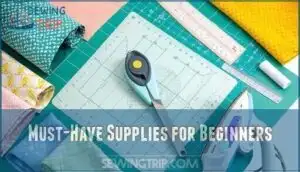
Before you dive headfirst into your first quilt, you’ll need to gather a handful of essential tools that will make the journey smoother and far more enjoyable. These sewing accessories form the foundation of all beginner quilting projects, helping you cut accurately, piece precisely, and troubleshoot mistakes along the way.
- Rotary cutters for clean, straight cuts through multiple fabric layers
- Cutting mats to protect your work surface and extend blade life
- Quilting rulers for measuring and guiding your rotary cutter with precision
- Seam rippers to fix stitching errors without damaging fabric
- Ironing essentials including an iron and pressing surface for crisp seams
Choosing The Right Fabric and Precuts
Your fabric choices can make or break your beginner quilting projects, so understanding cotton quality and precut shapes saves time and frustration. Most quilters lean toward 100% cotton for its durability and ease of use, with medium thread counts between 150 and 200 offering the ideal balance for flexibility and structure.
Precuts like charm squares, fat quarters, and precut strips simplify the process since color coordination is already done for you—perfect when you’re still finding your footing. Understanding the fabric’s GSM rating helps determine its suitability for different quilting projects.
About 64% of quilters shop local to see and feel fabric collections before buying, ensuring fabric weight and texture match their vision.
| Precut Type | Size | Best For |
|---|---|---|
| Charm Squares | 5" x 5" | Small patchwork, baby quilts |
| Fat Quarters | 18" x 21" | Variety in medium projects |
| Precut Strips (Jelly Rolls) | 2.5" wide | Strip quilts, borders |
Organizing Your Sewing Space
A well-organized sewing space keeps your supplies within arm’s reach and turns hours of hunting for tools into minutes of productive stitching. Invest in storage solutions like clear bins for fabric scraps and wall-mounted organizers for sewing accessories.
Efficient layout matters—place your machine near a cutting surface, and use supply inventory labels to track what you have.
Decluttering tips for sewing enthusiasts include grouping items by project type, making your sewing room feel less chaotic and more inspiring.
Simple Quilting Techniques for Success
Once you’ve got your tools and fabric ready, it’s time to learn the actual techniques that turn fabric into quilts.
The methods below will walk you through piecing, working with precuts, and mastering basic quilt blocks. These foundational skills make every project easier and help you build confidence as you stitch.
Basic Piecing and Stitching Methods
Learning to piece and stitch your quilt top is like learning to ride a bike—once you master the fundamentals, everything else becomes second nature. Focus on these core quilting techniques to build solid sewing skills:
- Accurate Seams: Maintain a consistent ¼" seam allowance for precise block alignment
- Chain Piecing: Feed fabric pairs through continuously to save time on beginner quilting projects
- Pressing Techniques: Press seams to one side, not open, for stronger quilts
- Fabric Grain: Cut along the straight grain to prevent stretching and distortion
- Stitch Length: Use 2.0–2.5mm stitches for secure seams that won’t unravel
Practice these basics with fabric scraps before starting full quilting for beginners projects.
Working With Precut Fabrics
Precut fabrics—think charm squares, jelly rolls, and fat quarters—take the guesswork out of fabric selection and let you jump straight into sewing without spending hours cutting individual pieces. Approximately 50% of beginner projects use precuts because fabric coordination is already taken care of, colors complement each other naturally, and you’ll avoid rookie mistakes like mismatched hues.
Charm squares (5" x 5"), jelly roll strips (2.5" wide), and fat quarters suit different project types—coasters need mini charm squares while table runners work beautifully with precut strips, offering genuine time-saving advantages.
Easy Quilt Block Tutorials
Triangle blocks, log cabin squares, and half-square triangles build quilting skills through manageable repetition—roughly 60% of easy quilt patterns rely on these foundational designs. You’ll master seam accuracy and block construction while exploring color palettes with one to three fabric selections.
Small quilting projects like pillow covers let you practice pattern variations before committing to larger beginner projects, and quilt block tutorials online guide you through each step without overwhelming your workspace. Beginning with a simple quilt pattern will help build confidence and skills.
Quick and Easy Small Quilt Projects
Small projects let you practice your skills without committing to a full-sized quilt. They’re quick to finish, so you’ll see results fast and build confidence along the way.
Here’s a look at three beginner-friendly options that won’t overwhelm your schedule or your fabric stash.
Quilted Mug Rugs and Coasters
If you’ve been looking for a way to ease into quilting without committing to a king-sized quilt, mug rugs and coasters are your perfect starting line—small enough to finish in an afternoon, yet practical enough to use every single day. Here’s how to get started with these bite-sized projects:
- Fabric selection matters: Choose cotton prints or solids that coordinate well, keeping your palette simple with two or three colors.
- Layer absorbent materials: Use cotton batting between fabric layers for coasters that actually protect surfaces from moisture.
- Add heat resistance: Consider insulated batting like Insul-Bright for mug rugs that accommodate hot beverages safely.
- Practice binding techniques: These small projects let you master edge-finishing without wrestling yards of fabric.
- Create gifting ideas: Stack a set of four coasters, tie with ribbon, and you’ve got a thoughtful handmade gift ready to go.
Most beginner quilters finish their first coaster in under three hours, making these projects ideal confidence-builders.
Simple Pincushions and Placemats
Once you’ve conquered coasters, pincushions and placemats become your next logical step—each one teaches you essential skills while delivering something you’ll actually reach for in your daily routine.
Pincushion variations let you practice stuffing techniques and pincushion tutorial steps using fabric scraps you’ve been hoarding, while placemats in different placemat shapes introduce quilting layers on a manageable scale.
These small projects for beginner quilters double as quick gifts, building beginner skills without the intimidation factor of larger easy quilting projects.
Beginner-Friendly Pillow Covers
Pillow covers offer the perfect canvas to practice half-square triangles and simple patchwork blocks without committing to an entire quilt top. You’ll find envelope closures require zero zipper insertion skills, while Simple Pillow Sham Tutorial options teach you to match standard pillow sizes.
Fabric choices expand as your confidence grows, letting you experiment with embellishment ideas on these quilted pillow projects before tackling larger designs.
Fast Quilt Patterns for Home Decor
Once you’ve mastered small projects, it’s time to move up to pieces that can fill your home with handmade warmth. Fast home decor patterns let you practice your skills while creating functional, gift-worthy items that actually get used.
The following projects balance quick completion times with impressive results, perfect for building confidence without overwhelming your schedule.
Table Runners and Table Toppers
Table runners and table toppers might seem purely decorative, but they’re actually one of the smartest first projects you can tackle—easy enough to finish in a weekend, forgiving when you’re still building your skills, and practical enough to use every single day.
Start with free quilt patterns designed for table runner projects, which usually measure between 12 and 18 inches wide. Charm packs work beautifully for these small projects, eliminating tricky fabric selection while giving you coordinated seasonal designs that suit any gifting occasion.
Easy Baby Quilts and Throws
Baby and toddler quilts bridge the gap between table runners and full-sized throws—large enough to feel rewarding, yet manageable for someone still gaining confidence. A typical baby quilt measures around 36" x 52", while throws reach approximately 50" x 65", giving you size variations that suit different gifting ideas and customization options.
Easy quilting patterns designed for these projects often rely on:
- Precut charm squares or jelly rolls that eliminate fabric selection guesswork
- Large blocks or strip piecing to speed up assembly and reduce seam matching
- Simple finishing techniques like straight-line quilting or tied corners
- Coordinated four-fabric palettes requiring just 1/2 to 3/4 yard each
You can complete a baby quilt in one focused weekend using precuts, making them ideal for last-minute gifts or practicing your piecing skills before tackling larger projects.
DIY Quilted Accessories for Gifting
Beyond blankets and table décor, quilted accessories make perfect handmade gifts—they’re quick to finish, practical to use, and show off your newfound piecing skills without demanding weeks of commitment.
Try quilted tote bags, oven mitts, or coasters using seasonal themes and leftover fabric scraps.
These customized gifting options generally cost $10–$25 in materials, yet they deliver gifts that feel far more thoughtful than store-bought alternatives.
Tips for Building Quilting Confidence
Building confidence as a quilter comes down to finding the right support, whether that’s through free resources, fellow makers, or keeping up with what’s popular in the craft.
You’ll grow faster when you connect with others who share your enthusiasm and learn from their successes.
Here’s where to look for the guidance and inspiration that will keep your momentum going.
Finding Free Patterns and Tutorials
If you’re just starting out, you might be wondering where to find quality patterns without breaking the bank—and the good news is that the internet is packed with free resources designed specifically for beginners like you. Here’s where to look:
- Designer websites – Many fabric artists share free quilting resources for beginners, including small quilt project tutorials and patterns you can download immediately.
- Pattern databases – Sites dedicated to quilting compile thousands of free patterns, from simple pincushions to baby quilts, searchable by skill level.
- Online resources with video tutorials – Roughly 65% of beginners rely on video-based tutorial types to guide their first projects step-by-step.
- Community sharing platforms – Fellow quilters post free tutorials and quilt patterns for beginners, creating a treasure trove of accessible projects.
Joining Online Quilting Communities
Once you’ve found a few patterns you love, connecting with other quilters online can turn what feels like a solitary hobby into a supportive, inspiring community. This community helps you troubleshoot problems, share finished projects, and pick up tips you won’t find in any tutorial.
Online forums and social media groups offer pattern sharing, skill exchange, and sewing and quilting inspiration daily. Many sites provide virtual workshops and email series with quilting resources for beginners, helping you learn alongside others who understand exactly where you’re in your quilting journey.
Inspiration From Popular Quilting Trends
What shapes are catching the eye of today’s quilters? Looking at what’s hot right now can spark your next project and show you where the quilting world is headed.
Here are three major trends shaping modern quilting:
- Modern geometrics and bold graphics dominate 78% of quilt pattern searches, with large-scale shapes and high-contrast layouts leading new releases.
- Sustainable quilting practices are gaining ground—56% of shops now stock organic cotton, while upcycled fabric projects make up 42% of beginner kits.
- Hand-stitching revival and vintage fusion blend traditional techniques like Sashiko with contemporary palettes, appearing in 47% of new patterns and driving workshop demand up 18%.
Digital innovation through design software and social media inspiration helps you tap into these trends, making it easier to find quilt patterns for small projects that reflect what’s current while building your sewing skills.
Frequently Asked Questions (FAQs)
How long does quilting a project typically take?
Over 90% of beginner quilters finish their first project within two weeks, especially when tackling small projects like coasters or pillow covers.
Project complexity, quilting experience, material choice, and tools used all influence how quickly you’ll complete easy quilting projects.
Whats the average cost of starting quilting?
Getting started with quilting runs anywhere from $45 to $145, depending on whether you upcycle fabric or buy premium quilting cotton.
Supply cost breakdown includes a rotary cutter, mat, ruler, thread, and needles alongside fabric selection for quilting, making precut vs yardage a cost-saving consideration for beginner sewing projects.
Can I quilt without a sewing machine?
Yes, you can quilt without a sewing machine through hand quilting, tying quilts with yarn knots, or creating no-sew quilts using glue basting and fabric manipulation techniques—perfect beginner sewing projects for developing essential quilting skills.
How do I fix common beginner quilting mistakes?
Mistakes are just fabric’s way of teaching you something new. Fix Seam Allowance errors by unpicking stitches carefully, then resew with a quilting ruler for Consistent Stitching.
Trim blocks for Squaring Blocks, press seams to prevent Fabric Bunching, and use pins for Point Matching—each easy tutorial strengthens your quilting skills development.
What size quilt should I make first?
A lap quilt or baby quilt works best for beginners, usually around 40×50 inches.
This size offers manageable fabric waste and time commitment while building your confidence through small projects and easy quilting tutorial techniques.
Conclusion
You’re not just stitching fabric—you’re threading together patience, creativity, and a little courage. Easy quilting projects remove the pressure of aiming for flawlessness, letting you focus on the rhythm of your hands and the satisfaction of finishing something tangible.
Each completed mug rug or table runner becomes proof that you can build skills one block at a time. The next project won’t feel quite as intimidating, and eventually, you’ll realize the only thing standing between beginner and quilter was simply getting started.
- https://suzyquilts.com/what-quilters-want-in-2023/
- https://blog.siysewityourself.com/2024/05/10/quilting-for-beginners-7-easy-quilt-projects-to-try/
- https://www.youtube.com/watch?v=T6vaObp-TO0
- https://www.reddit.com/r/quilting/comments/10434jc/what_would_be_a_good_small_and_easy_project_to/
- https://craftindustryalliance.org/the-size-of-the-quilting-market-quilting-trends-survey-results-2025/

